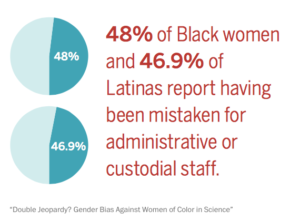
After spending an average of seven years to meet their collegiate qualifications, working hard to climb the ranks in the STEM (science, technology, engineering and math) fields and making vital contributions to the world of science, Black female scientists are still being asked to provide additional evidence to prove they are competent scientists and not janitors.
This new report by the Center for WorkLife Law at the University of California, Hastings College of the Law, “Double Jeopardy? Gender Bias Against Women of Color in Science,” revealed that 100 percent of 60 scientists who were interviewed for the study said they experienced racial bias and discrimination.
Many of the interviewees shared similar experiences about being mistaken for cleaning staff at all hours of the day.
“I always amuse my friends with my janitor stories,” one Black woman scientist told researchers. “But it has happened, not only at weird hours.”
In an online survey to accompany the 60 interviews, more than three-fourths of the subjects had also experienced racial bias and were asked to provide “evidence of their competence.”
While this occurrence was common for both Black and Hispanic women, the study revealed that Black women were particularly at risk of dealing with racism and “bleak isolation” in the STEM fields.
It listed four specific types of gender bias that commonly impact women of color — being asked to prove themselves, being seen as either too masculine or too feminine, motherhood bias and a struggle with other women in the company fighting over the limited number of opportunities for women in the field.
In addition to being mistaken for janitors, these women were also asked to fulfill administrative duties like filling out grant forms or coordinating people’s meetings, the report claimed.

“The numbers have just not moved in all the STEM disciplines in the last 10 years,” said Janet Koster, executive director of the Associates for Women in Science, according to The Washington Post. “Women start out, but seep out of the pipeline when they go into early careers or academic education. For people of color, we’re not even getting them into the pipeline in the first place. That has to change.”
According to Koster, the racial bias is starting while Black women are still seeking their Ph.D’s.
Out of nearly 900 women who received Ph.D’s in mathematics and statistics in 2012, Koster says only 10 were Black women and another 10 were Hispanic.
It’s a statistic that Koster describes as “tragic.”
The end result of such tragic statistics is a “hostile” environment for Black women in STEM who defied all odds to become qualified scientists only to be mistaken as custodial or administrative staff.


